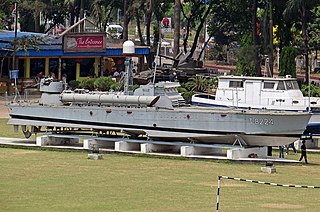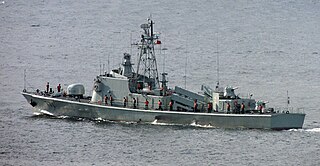
In naval terminology, a destroyer is a fast, maneuverable, long-endurance warship intended to escort larger vessels in a fleet, convoy or battle group and defend them against powerful short range attackers. They were originally developed in 1885 by Fernando Villaamil for the Spanish Navy as a defense against torpedo boats, and by the time of the Russo-Japanese War in 1904, these "torpedo boat destroyers" (TBDs) were "large, swift, and powerfully armed torpedo boats designed to destroy other torpedo boats". Although the term "destroyer" had been used interchangeably with "TBD" and "torpedo boat destroyer" by navies since 1892, the term "torpedo boat destroyer" had been generally shortened to simply "destroyer" by nearly all navies by the First World War.
A patrol boat is a relatively small naval vessel generally designed for coastal defence, border protection, immigration law-enforcement, search and rescue duties. There have been many designs for patrol boats. They may be operated by a nation's navy, coast guard, police force or customs and may be intended for marine or estuarine or river environments. They are commonly found engaged in various border protection roles, including anti-smuggling, anti-piracy, fisheries patrols, and immigration law enforcement. They are also often called upon to participate in rescue operations.

The term brown-water navy or riverine navy refers in its broadest sense to any naval force capable of military operations in littoral zone waters. The term originated in the United States Navy during the American Civil War, when it referred to Union forces patrolling the muddy Mississippi River, and has since been used to describe the small gunboats and patrol boats commonly used in rivers, along with the larger "mother ships" that supported them. These mother ships include converted World War II-era Landing Crafts and Tank Landing Ships, among other vessels.

The Southern Theater Command Navy, or the South Sea Fleet is one of the three fleets of the Chinese People's Liberation Army Navy, operating in the South China Sea under the Southern Theater Command. It is headquartered in Zhanjiang, Guangdong Province.

The People's Liberation Army Navy Surface Force is the surface warfare branch of China's People's Liberation Army Navy (PLAN), consisting of all surface vessels in operational service with the PLAN. The PLAN Surface Force operates 661 ships organized into three fleets: the North Sea Fleet, the East Sea Fleet and the South Sea Fleet.
Yulin-class gunboats were gunboats of the People's Republic of China's People's Liberation Army Navy. They first entered service in the 1960s, but had been completely taken out of active service by the late 1990s, and were transferred to law enforcement agencies. However, just like the Shantou, Huangpu and Beihai classes that were transferred for law enforcement adaptation, these obsolete and aging boats were not satisfactory in their new roles due to their low maximum speed, sometime as low as 10 knots, which was not sufficient to catch the smugglers' high-speed motorboats. As a result, these boats were subsequently transferred again, this time to reserves, subordinated to naval militia in various Military Maritime Districts in China as training boats and port security and patrol boats within the confines of the harbors. Increasingly, the class is assigned to ferry duties.
The Huangpu-class gunboat were gunboats of the People's Republic of China's People's Liberation Army Navy, with production first begun at Jiangnan Shipyard on January 20, 1953, after request was submitted in October 1952.. These boats were designated as Type 53A, and a slightly modified version was designated as Type 54A. They entered service in the 1950s and had been completely taken out of active service by the early 2000s and were transferred to law enforcement agencies. However, just like the Shantou, Beihai and Yulin classes that were transferred for law enforcement adaptation, these obsolete and aging boats are not satisfactory in their new roles due to their low maximum speed, sometime as low as 10 knots, which was not fast enough to catch the smugglers’ high speed motorboats. As a result, these boats were subsequently transferred again, this time to reserves, subordinated to naval militia in various Military Maritime Districts in China as training boats and port security / patrol boats within the confines of the harbors.
The Shantou-class gunboat was a Chinese-built gunboat of the People's Republic of China's People's Liberation Army Navy. Known in the United States as the "Swatow" class gunboat, it was based on the Soviet P-6 class torpedo boat. The boat is designated as Type 55A. Instead of being wooden hulled, and having torpedoes as the main armament, the Shantou class is steel-hulled, with guns as the main armament. The Shantou is the predecessor of the Type 062 gunboat, or more commonly known as the Shanghai-I & II class.

The P 4 class torpedo boat (TB) were aluminum-hulled torpedo boats of the People's Republic of China's People's Liberation Army Navy. Based on the Soviet K-123 hydroplane design, they were armed with twin 14.5-millimetre (0.57 in) machine guns, and two 17-inch (43 cm) torpedoes. This class is currently considered obsolete, but was not completely retired from active service, being placed in reserve until the mid-1990s.

The Type 062 gunboat is a class of gunboat of the People's Liberation Army Navy first developed and constructed in the 1950s. This unsophisticated class is relatively well-armed for its size and is the most widely built and exported Chinese naval vessel in terms of numbers. A total of 30 were built, initial boats being known as the Shanghai I class and later slightly improved boats being known as the Shanghai II class. The Shanghai I class was slightly smaller than its successor, the Shanghai II class, displacing 125 tons instead of 135 tons, and had a twin Chinese Type 66 57 mm gun mount forward. All other specifications are identical to the Shanghai II class, which replaced the 57 mm with twin 37 mm gun mounts. Some boats remained in active service well into the early 1990s in the PLA navy and longer in the case of the Korean People's Navy.

Project 122bis submarine chasers were a Soviet design which were exported throughout the communist bloc in the 1950s. The first ship, BO-270, was built at Zelenodolsk in 1945-1947 and a total of 227 were built for Soviet Navy (175) and border guard until 1955. As well as this, twenty Project 357 despatch vessels were built on the same hull, but were lightly armed.

The Type 037 corvette is a series 400–500 ton corvette type classes in service with the People's Liberation Army Navy. Unlike western navies, the People's Liberation Army Navy does not have dedicated patrol boats in its inventory. Instead, a large variety of corvette type classes, in the form of missile boats and submarine chasers fulfill the tasks of patrolling China's territorial waters. The Egyptian Navy operates eight vessels.
The Type 010 class minesweeper is the Chinese versions of the Russian Soviet T-43 class oceangoing minesweeper.

The Myanmar Navy is the naval warfare branch of the armed forces of Myanmar. With 24,000 personnel on duty, the navy operates more than 150 vessels. Prior to 1988, the navy was small, and its role in counter-insurgency operations was smaller than those of the army and the air force. The navy has since been expanded to take on a more active role in defense of Myanmar's territorial waters.

Naval trawlers are vessels built along the lines of a fishing trawler but fitted out for naval purposes; they were widely used during the First and Second World Wars. Some—known in the Royal Navy as "Admiralty trawlers"— were purpose-built to naval specifications, others adapted from civilian use. Fishing trawlers were particularly suited for many naval requirements because they were robust vessels designed to work heavy trawls in all types of weather, and had large clear working decks. A minesweeper could be created by replacing the trawl with a mine sweep. Adding depth charge racks on the deck, ASDIC sonar below, and a 3-inch (76 mm) or 4-inch (102 mm) gun in the bow equipped the trawler for anti-submarine duties.

NS Daures (C12) is a patrol boat of the Namibian Navy and sister ship of NS Brukkaros. Formerly a People's Liberation Army Navy Haiqing-class submarine chaser, it was commissioned on 27 October 2017 into the Namibian Navy. The vessel is used to patrol Namibia's exclusive economic zone.

NS Brukkaros (C13) is a patrol boat of the Namibian Navy. It was commissioned on 27 October 2017. Previously a Haiqing-class submarine chaser of the People's Liberation Army Navy, it was donated by the Chinese government in 2014.

The RBU-1200 is a Russian anti submarine rocket launcher. The weapon system is remotely similar to the British Hedgehog anti submarine rocket launcher from the Second World War.










